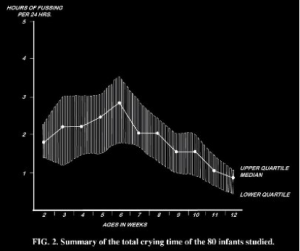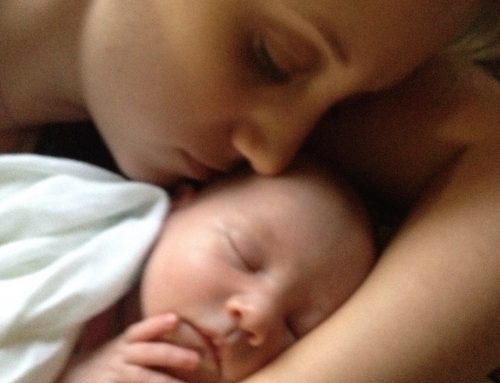New babies have emerged from a calm, dark womb where on a particularly interesting day, they will see the umbilical cord floating past. To a foetus that’s a big day!
At birth they are suddenly ejected into a busy world of lights, faces, and strange objects; of sounds and noise; of hunger, thirst and separation from the body they know intimately from the inside. Some babies cope well and some take time to adjust. But for all, it is a time for calmness, nurturing, feeding, sleep and contact with that loving body, now from the outside.
After a week or two of stunned silence, babies usually start to wake up and get increasingly needy. If they become particularly noisy and unsettled at this time they are often accused of having ‘wind’ or the dreaded ‘colic’.
If you conducted a large study where you gave thousands of parents diaries to keep, in which to record how much and when their babies fussed, cried and were unsettled, you would end up with a chart like this, with hours of crying up the side and weeks of postnatal life along the bottom:
At about 2 weeks babies start getting unsettled and this peaks at 6 weeks. At that time the average amount of crying and fussing is 3 hours a day, 50% of the population cry more, 50% less. Most of the crying is in the evening with a smaller peak in the morning. The amount of crying then decreases gradually week by week, until about 3 months of age when it falls off a cliff. Suddenly our babies are more settled and resilient.
So that’s ‘normal’ crying. It’s what normal babies do. They aren’t sick or ‘suffering from wind’, they are adapting to life outside the womb.
Isn’t it interesting that ‘colic’ has exactly the same time profile? For years it’s been called ‘evening colic’ and ‘three month colic’ to describe this very profile. If you read the standard medical texts on the subject they say that, ‘Colic occurs in 10% of the baby population, with over 90% of them having no organic disease’.
That’s the giveaway line.
The so-called ‘colicy’ babies are those criers on our graph in the top 10%. They are just as normal but more sensitive than the others. They are not suffering from a disease. We should stop looking and blaming their tummies for what is going on their heads!
Often these tense, upset babies try to calm themselves in the only way they know. By sucking and sucking and sucking.
So they start feeding more (which makes them vomit and reflux more), this also overloads the ability of their bowel to absorb all the milk (so they get ‘wind’ and explosive poos, misdiagnosed as lactose intolerance) or they scream and draw their knees up because they are tense and stressed (misdiagnosed as tummy ache). Their family responds to the extra noise by getting stressed themselves and by handling the baby more.
And why is it worse at Christmas? At this time of year the world is busier and everyone more stressed than usual. Think about your last trip to the shops recently. Have you noticed the frenetic energy in the stores and the increase in road rage (and that’s just in the parking station)? Sensitive babies are already trying to adjust to the busy world outside the womb, without that extra load.
So new mothers, If you can, abandon Christmas for this year and leave the cooking to others. Retreat to a quiet room. If people want to see your baby, show them a baby picture on your phone. Santa will still come and your baby will thank you for it.











Hi Dr Chilton. I am currently on day 2 of bore your baby to sleep. I have the room darkened with block out curtains, a white noise sound machine, a clock sound that plays at 70BPM and my baby wrapped. She is 8 weeks old and we have been struggling from almost week 2 of her life. She shows the classic signs when waking every 40min legs bunching, arms flapping and cannot resettle her self. I have done numerous patting and shooshing for days on end but alas not many successful resettles. I am hoping as day 2 of boring her will bring about more sleep. If day 2 goes as bad as day 1 are there any suggestions I can try? I am struggling.
Also I live over at Wilsons Creek near Mullumbimby and wanted to know do you know of any mother craft nurses/nannies in the area that can help me with settling? Thank you.
You could come and see me at Bangalow if things continue. There is a Tresillian clinic at Lismore now.
This is a reaaly great insight and bore your baby to sleep also opened my eyes. My baby was diagnosed with “colic” at 3 weeks as he was straining, groaning and screaming from about 3 in the morning till 6am.
Our issue is we are from the UK so the first 9 weeks of his life have been bombarded by visits from the grandparents trying to cram in a year of cuddles and fuss. Every night I find it harder and harder to settle him to sleep and he’s such an alert boy he gets so overstimulated just staring out of the window. I’m looking forward to trying the bore to sleep method.
Is there anything else I can do in the short term to reduce mine and his stress without banning the grandparents from chatting to him constantly and cuddling him?
Perhaps print a copy my blog and stick it on the fridge for them to read!
I finally bored our baby to sleep for 2 days the day after the grandparents had left. It worked we finally had a calm baby who slept well again and smiled a lot more than he had been. Thank you so much! So I went out and bought your book. If we have another I’ll be subtly sharing your posts on Facebook before they arrive 🙂
Thank you dr Chilton for a great blog and excellent books, they’ve been truly eye-opening.
I’ve been trying to ‘bore to sleep’ my 9 weeks old daughter as she can only fall asleep while breastfeeding or being carried around. I usually react when I see her tiredness signs but she starts or escalates crying when I try to cuddle, make skin to skin contact or swaddle her. At the end I carry her until she calms down and falls asleep. Her crying reminds me of ‘CIO’ methodology and I’m confused if it’s something that’s normal?
The ‘Crying it out’methodology occurs when you are not holding your baby! You’re doing fine. Hold her or feed her until she falls asleep, she will change soon enough. Stop worrying – she sounds really normal and her responses are appropriate. Read my blog about feeding to sleep: